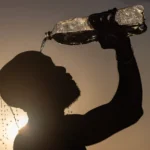It’s tempting to see heatwaves as indiscriminate forces, touching all under the same sun. But that view wilfully ignores a growing body of evidence. When the mercury rises, women face greater risks, deeper hardships, and fewer safeguards, especially across Africa.
New findings from Climate Central confirm what many frontline health workers across the continent have warned for years. In the last five years alone, the number of pregnancy heat-risk days — days when extreme heat heightens the risk of complications like preterm birth, low birth weight, and stillbirth — has more than doubled globally due to human-caused climate change.
The report analysed heat trends in 242 global cities and across 222 countries from 1990 to 2023. In sub-Saharan Africa, the trend is especially stark. Many countries have seen an entire additional month or more of these high-risk days annually since 2020, without the corresponding increase in health system capacity to address it.
In parts of Africa where health facilities often lack stable electricity, fans, or shaded maternity wards, these extra weeks of intense heat are more than just uncomfortable; they’re potentially fatal. Women in these regions are navigating pregnancy in conditions that defy medical safety guidelines, with little institutional support and few cooling interventions.
“Rising temperatures may not always make headlines,” said Abosede Lewu, consultant obstetrician-gynaecologist and founder of Girlsaide Initiative. “But for women carrying life inside them, the heat can be devastating.”
Why Women Bear the Heat Differently
Women, especially those who are pregnant, elderly, or living with disabilities, face heightened risks from extreme heat.
Their vulnerability isn’t solely biological; it’s compounded by social and cultural expectations. In many communities, women are responsible for cooking, fetching water, and caring for children — duties typically carried out in poorly ventilated, high-heat environments. Restrictive dress norms and inadequate housing design further limit their ability to stay cool. Without tailored interventions, these overlapping risks can lead to dehydration, heat exhaustion, and lasting health complications.
They stem from a complex interaction of physiological factors, cultural expectations, and systemic neglect.
In many African settings, the risks are exacerbated by economic inequality. Women are 50% less likely than men to have access to cooling technologies. Many work in informal outdoor sectors, lacking adequate shelter or breaks. In communities where air conditioning is a luxury and rural areas where fans are scarce, the odds stack up against women’s health and safety.
Hein Daanen, professor of exercise physiology at VU University in Amsterdam, has studied how heat affects the human body. “Roughly, elderly people sweat half the amount compared to youngsters, and females half that of males,” he said. That means women, particularly older ones, have the lowest ability to cool themselves.
Other researchers agree. Ollie Jay, professor of heat and health at the University of Sydney, found that even among healthy adults, women sweat less than men under identical heat stress. “We do not really know yet if this explains the higher female mortality and morbidity during heatwaves,” he said. “But the most likely answer is that it’s a combination of factors.”
Mike Tipton, professor and leading expert in applied physiology at the University of Portsmouth, adds that the menstrual cycle may play a role. Women’s core temperatures rise after ovulation. That, combined with a higher surface area-to-mass ratio, means they absorb heat more quickly.”
When Heat Strikes During Pregnancy
Pregnancy introduces a cascade of physical changes, from hormone surges to increased cardiovascular demands. These changes already place extra strain on the body. Extreme heat adds more.
“Before pregnancy, a woman is just herself,” the obstetrician explained. “But when she becomes pregnant, her body now supports two or more lives. The kidneys work harder. The heart works harder. The skin stretches and sweats more. She needs more hydration to keep up.”
These adjustments are part of what makes pregnancy viable. But they also make expectant mothers especially sensitive to heat.
Without sufficient hydration, the consequences can be severe. “If a woman is dehydrated, blood flow to the placenta might reduce. That puts the baby at risk. She may also faint or suffer from heat exhaustion. In serious cases, it could cause early labour or stillbirth.”
These risks are magnified in urban areas, where poor ventilation and cramped housing are common. In such environments, cooling becomes a privilege rather than a public health necessity.
Medical experts encourage proactive strategies such as taking regular baths, drinking water frequently even when not thirsty, and, if possible, avoiding heavy clothing and limiting physical activity during the hottest parts of the day
The research findings and data by Climate Central show the rise in pregnancy heat-risk days isn’t just an abstract threat. It signals an increasing frequency of real-life emergencies, such as women collapsing at home, labouring in overheated clinics, or giving birth in facilities without cooling support.
Despite these trends, many pregnant women avoid drinking water to limit trips to the toilet, especially in communities with poor sanitation. “But dehydration doesn’t just impact the pregnancy,” the obstetrician said. “It affects breast milk production after birth, too. And in settings where formula is either unaffordable or unsafe, that’s a public health crisis.”
Babies and Breastfeeding in a Hotter World
Newborns are among the most heat-sensitive people on earth. Their tiny bodies haven’t developed the ability to regulate temperature effectively. In poor ventilation, even a short heatwave can be fatal.
“They’re just adapting to the world,” Lewu said. “And when that world is too hot, it overwhelms their system. Poor air circulation, overcrowding, and over-layering can all lead to overheating.”
In many communities, newborns are swaddled in thick layers to ward off mosquitoes, but this practice can backfire. “Use mosquito nets instead. Dress the baby lightly,” she advised. “Heatstroke in a newborn is preventable.”
Breastfeeding mothers face their own set of challenges. “Breast milk is mostly water. If the mother is dehydrated, milk production drops. That affects the baby’s nourishment and immune protection. And when formula becomes the fallback, not everyone can afford it or mix it with safe water.”
Fertility, Hormones, and Menopause
The health risks don’t end after childbirth. Across a woman’s life cycle, from menarche to menopause, heat can trigger hormonal disruptions and systemic distress.
“Heat can delay or interrupt menstrual cycles,” the gynaecologists and obstetricians said. “I’ve seen patients who moved from tropical to temperate climates and suddenly began experiencing irregular periods or new menstrual pain. It shows how climate stress impacts reproductive health.”
Women with conditions like PCOS or endometriosis face compounded stress. “They’re already dealing with hormonal imbalances. Add heat to that, and you’re amplifying the discomfort and risk,” she said. “It makes them more irritable, more exhausted, and potentially less responsive to treatment.”
Even menopause brings its own form of thermal distress. The medical doctor explained that women in their 40s and 50s often experience hot flashes — sudden, intense heat sensations from the chest up. Combining that with high ambient temperatures can become unbearable. “I’ve seen women break into a sweat during consultations, while everyone else is cold,” she said.
Still, most climate-health messaging remains gender-blind. Few heat advisories mention pregnancy. Fewer still address menopause. In Africa, where women make up the majority of caregivers and frontline workers, that gap is both a health risk and a policy failure.
Listening, Learning, and Localising the Message
Effective heat adaptation requires not just information, but targeted communication. Lewu emphasised that messaging must reach the right people in the right formats. In many communities, public health messaging doesn’t get to the people who need it most. When it does, it often misses the mark.
Reaching rural populations means going beyond television campaigns. It means radio jingles, town criers, WhatsApp groups, and respected local voices. And it means tailoring the message to the cultural context — in pidgin, Hausa, Igbo, Yoruba, Zulu, and Swahili.
“We don’t yet have enough public service announcements that speak to women where they are,” she said. “That’s a communication failure.”
A Gender-Informed Path Forward
Extreme heat is becoming one of the most persistent public health threats of our time. But without a gender-informed approach, efforts to protect communities will continue to fall short.
The Climate Central report makes one thing clear: the problem isn’t just the rising temperature. It’s how that temperature intersects with inequality, infrastructure gaps, and underfunded health systems.
In the United States, nearly half of all pregnancy heat-risk days recorded since 1990 occurred in the last five years alone. But in many African regions, the impact is likely worse, yet less measured. Less studied. Less reported.
“It’s not that men don’t suffer,” Lewu said. “But women experience heat differently, based on hormonal stages, body composition, and social roles. That needs to be part of how we design interventions.”
According to experts, disaggregated data, targeted research, and inclusive public health campaigns are urgently needed. We can’t treat the population as a monolith anymore. If we don’t understand who is most at risk and why, we can’t build effective interventions. Sustainable solutions must focus on equity and precision, not one-size-fits-all approaches.
As the climate crisis intensifies, failing to integrate gender into adaptation planning will be measured in lives lost, pregnancies endangered, and unhealthy children. Effective, sustainable public health strategies must recognise that women are not a marginal group; they are central to the resilience of families, communities, and economies.










